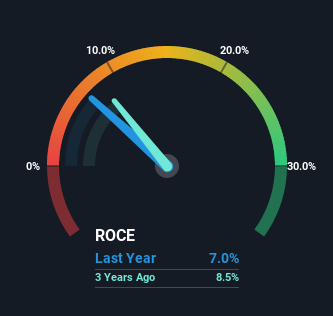- United States
- /
- Aerospace & Defense
- /
- NasdaqGS:VSEC
VSE (NASDAQ:VSEC) Could Be Struggling To Allocate Capital
What trends should we look for it we want to identify stocks that can multiply in value over the long term? Firstly, we'll want to see a proven return on capital employed (ROCE) that is increasing, and secondly, an expanding base of capital employed. If you see this, it typically means it's a company with a great business model and plenty of profitable reinvestment opportunities. However, after investigating VSE (NASDAQ:VSEC), we don't think it's current trends fit the mold of a multi-bagger.
Understanding Return On Capital Employed (ROCE)
For those that aren't sure what ROCE is, it measures the amount of pre-tax profits a company can generate from the capital employed in its business. Analysts use this formula to calculate it for VSE:
Return on Capital Employed = Earnings Before Interest and Tax (EBIT) ÷ (Total Assets - Current Liabilities)
0.07 = US$54m ÷ (US$958m - US$180m) (Based on the trailing twelve months to September 2022).
Thus, VSE has an ROCE of 7.0%. In absolute terms, that's a low return and it also under-performs the Commercial Services industry average of 9.3%.
See our latest analysis for VSE

In the above chart we have measured VSE's prior ROCE against its prior performance, but the future is arguably more important. If you'd like to see what analysts are forecasting going forward, you should check out our free report for VSE.
What The Trend Of ROCE Can Tell Us
In terms of VSE's historical ROCE movements, the trend isn't fantastic. Around five years ago the returns on capital were 11%, but since then they've fallen to 7.0%. Although, given both revenue and the amount of assets employed in the business have increased, it could suggest the company is investing in growth, and the extra capital has led to a short-term reduction in ROCE. And if the increased capital generates additional returns, the business, and thus shareholders, will benefit in the long run.
What We Can Learn From VSE's ROCE
In summary, despite lower returns in the short term, we're encouraged to see that VSE is reinvesting for growth and has higher sales as a result. In light of this, the stock has only gained 8.6% over the last five years. Therefore we'd recommend looking further into this stock to confirm if it has the makings of a good investment.
VSE does come with some risks though, we found 2 warning signs in our investment analysis, and 1 of those makes us a bit uncomfortable...
While VSE isn't earning the highest return, check out this free list of companies that are earning high returns on equity with solid balance sheets.
New: Manage All Your Stock Portfolios in One Place
We've created the ultimate portfolio companion for stock investors, and it's free.
• Connect an unlimited number of Portfolios and see your total in one currency
• Be alerted to new Warning Signs or Risks via email or mobile
• Track the Fair Value of your stocks
Have feedback on this article? Concerned about the content? Get in touch with us directly. Alternatively, email editorial-team (at) simplywallst.com.
This article by Simply Wall St is general in nature. We provide commentary based on historical data and analyst forecasts only using an unbiased methodology and our articles are not intended to be financial advice. It does not constitute a recommendation to buy or sell any stock, and does not take account of your objectives, or your financial situation. We aim to bring you long-term focused analysis driven by fundamental data. Note that our analysis may not factor in the latest price-sensitive company announcements or qualitative material. Simply Wall St has no position in any stocks mentioned.
About NasdaqGS:VSEC
VSE
Provides aviation aftermarket parts distribution and maintenance, repair, and overhaul services for air transportation assets for commercial and government markets.
Solid track record with excellent balance sheet.
Similar Companies
Market Insights
Community Narratives



